Dim sum is a popular Asian cuisine that many people enjoy, but is it really a healthy option? In this section, let’s delve into the nutrition facts and explore the various factors that affect the healthiness of dim sum dishes.
Dim sum can be a delicious part of Hongkongers’ lifestyle, but it’s important to consider the nutrition facts. While steamed foods are often seen as healthier, this doesn’t necessarily apply to dim sum. Many dim sum dishes are high in calories, fat, and sodium, which can contribute to heart disease. Some common culprits include offal, steamed chicken feet with black bean sauce, steamed bean curd sheet roll, meatballs, and sticky rice wrapped in lotus leaf. These dishes can be calorie-dense and fatty.
However, there are healthier dim sum options available such as shrimp dumplings, scallop dumplings, spinach dumplings, and steamed chicken buns. It’s also important to order a plate of greens, minimize the use of condiments like soy sauce, drink tea or water with the meal, and complement it with fruits like oranges, kiwis, and apricots. Steaming is a healthier cooking method as it retains vitamins, minerals, and reduces the need for oil. Overall, it’s possible to enjoy dim sum in a healthier way by making mindful choices.
Key Takeaways:
- Dim sum dishes can be high in calories, fat, and sodium, which can contribute to heart disease.
- Some dim sum dishes to avoid include offal, steamed chicken feet with black bean sauce, steamed bean curd sheet roll, meatballs, and sticky rice wrapped in lotus leaf.
- Healthier dim sum options include shrimp dumplings, scallop dumplings, spinach dumplings, and steamed chicken buns.
- Ordering a plate of greens, minimizing condiment use, and complementing the meal with fruits can enhance the nutritional value of dim sum.
- Steaming is a healthier cooking method for dim sum as it retains vitamins and minerals while reducing the need for excessive oil.
Understanding Dim Sum Nutrition and Ingredients
To understand whether dim sum is healthy or not, it’s important to have an understanding of its nutrition and the ingredients used. Dim sum is a popular Cantonese cuisine that consists of bite-sized dishes typically served in bamboo steamers. While dim sum can be a delicious and enjoyable dining experience, it’s essential to consider the nutritional value of these dishes.
When it comes to dim sum, the nutrition profile can vary depending on the ingredients and cooking methods employed. Some common ingredients found in dim sum include lean meats like chicken and shrimp, vegetables such as spinach and bok choy, and staple foods like rice and wheat flour wrappers. These ingredients can provide essential nutrients like protein, fiber, vitamins, and minerals.
However, it’s important to be aware of certain high-calorie and fatty dim sum dishes that can be less healthy options. Some examples include deep-fried options like spring rolls and pan-fried dumplings, which can be high in unhealthy fats. It’s also worth noting that some dim sum dishes may contain high amounts of sodium, such as those with soy sauce or other condiments.
| Dim Sum Dish | Calories | Fat (g) | Sodium (mg) |
|---|---|---|---|
| Steamed Shrimp Dumplings (Har Gow) | 61 | 0.9 | 216 |
| Steamed Pork Dumplings (Siu Mai) | 61 | 2.3 | 157 |
| Steamed BBQ Pork Buns (Char Siu Bao) | 160 | 4.5 | 367 |
| Steamed Vegetable Dumplings (Chai Siu Bau) | 42 | 0.5 | 116 |
I always make sure to choose steamed options like shrimp dumplings and vegetable dumplings when enjoying dim sum. They are delicious and have relatively lower calorie and fat content compared to fried or pan-fried dishes. It’s also a good idea to limit the use of soy sauce or opt for low-sodium alternatives to reduce sodium intake.
Healthier Dim Sum Choices for a Balanced Diet
While it’s important to be mindful of certain dim sum dishes that may not be as healthy, there are plenty of nutritious options available as well. Steamed dumplings filled with lean proteins like shrimp or scallops provide a good source of protein without excessive calories or fat. Steamed vegetable dumplings, made with a combination of fresh greens and other vegetables, can also be a great choice.
If you’re looking for something heartier, consider steamed chicken buns made with lean chicken meat and whole wheat flour wrappers. These buns are a good source of protein and complex carbohydrates. Additionally, including a plate of steamed greens, such as bok choy or Chinese broccoli, can add fiber, vitamins, and minerals to your meal.
It’s also important to remember that portion control plays a vital role in maintaining a balanced diet, even when enjoying dim sum. Try to savor the various flavors and textures of each dish and listen to your body’s hunger and fullness cues. By making mindful choices and incorporating healthier dim sum options into your meal, you can enjoy this culinary delight while still supporting your overall health and well-being.
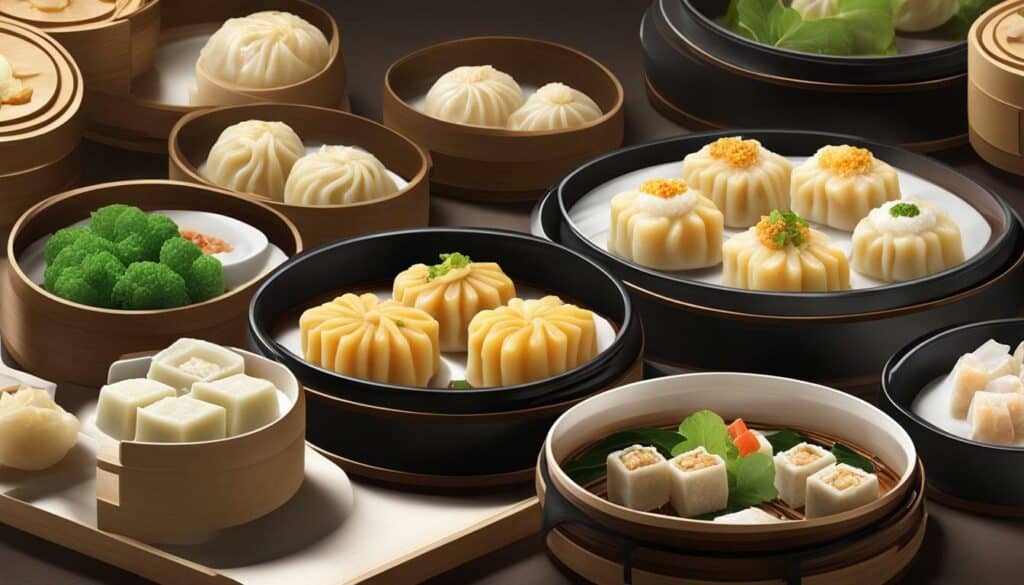
While dim sum can be delicious, there are some dishes that are higher in calories and fat content and should be avoided if you’re looking for healthier options. These dishes can contribute to weight gain and increase the risk of heart disease. Here are a few dim sum dishes that you might want to steer clear of:
| Dish | Calories per serving | Fat content per serving |
|---|---|---|
| Steamed Chicken Feet with Black Bean Sauce | 214 | 14g |
| Steamed Bean Curd Sheet Roll | 230 | 14g |
| Meatballs | 270 | 20g |
| Sticky Rice Wrapped in Lotus Leaf | 340 | 18g |
These dishes can be quite calorie-dense and contain high levels of fat. Consuming them regularly may lead to weight gain and have adverse effects on your health. However, don’t worry! There are healthier dim sum options available that you can enjoy without sacrificing flavor or tradition.
Instead of opting for the high-calorie and fatty dim sum dishes mentioned above, consider choosing dishes that are lighter and lower in calories. Some healthier options include shrimp dumplings, scallop dumplings, spinach dumplings, and steamed chicken buns. These dishes are still packed with flavor and offer a more nutritious alternative to their calorie-laden counterparts.
When enjoying dim sum, it’s also important to balance your meal by ordering a plate of greens, minimizing the use of condiments like soy sauce, and opting for healthier beverage choices like tea or water. Additionally, complement your dim sum meal with fruits like oranges, kiwis, and apricots to add extra vitamins and minerals to your diet.
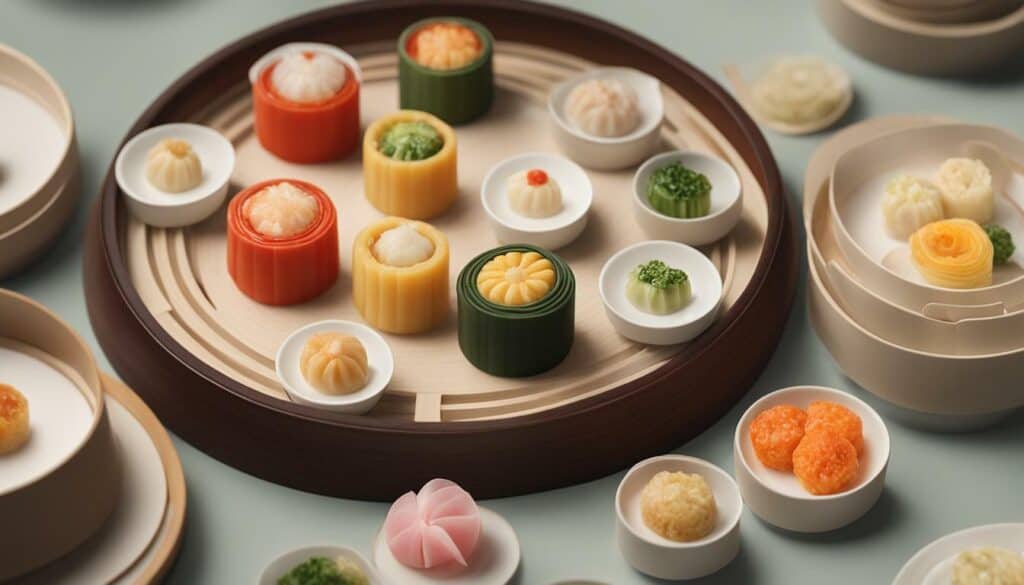
Steaming is a common cooking method for dim sum, and it’s also a healthier option. Steaming helps retain the vitamins and minerals in the ingredients and reduces the need for excessive oil. The result is a lighter and more nutritious meal, making steamed dim sum dishes a great choice for those seeking healthier options.
By making mindful choices and opting for healthier dim sum dishes, you can enjoy this culinary delight while still maintaining a balanced and nutritious diet. Remember to listen to your body and choose dishes that align with your health goals. With a little bit of knowledge and awareness, you can savor the flavors of dim sum without compromising your well-being.
Healthier Dim Sum Choices for a Balanced Diet
Not all dim sum dishes are unhealthy. There are several options that can be part of a balanced diet and offer health benefits. Instead of indulging in calorie-dense and fatty dim sum dishes, consider ordering healthier alternatives that still pack a flavorful punch.
One popular option is shrimp dumplings. These delicate parcels are filled with succulent shrimp and wrapped in a thin, translucent skin. They are steamed to perfection, making them lower in calories and fat compared to their fried counterparts. Shrimp is also a good source of lean protein, omega-3 fatty acids, and essential minerals.
Another healthy choice is scallop dumplings. These bite-sized delights combine the delicate sweetness of scallops with a light and chewy wrapper. Scallops are rich in protein, vitamin B12, and omega-3 fatty acids, making them a nutritious addition to your dim sum spread.
If you’re looking for a vegetarian option, spinach dumplings are a great choice. These vibrant green dumplings are filled with nutritious spinach and other vegetables. Spinach is packed with vitamins A, C, and K, as well as iron and calcium. By opting for spinach dumplings, you can add a dose of greens to your dim sum meal.
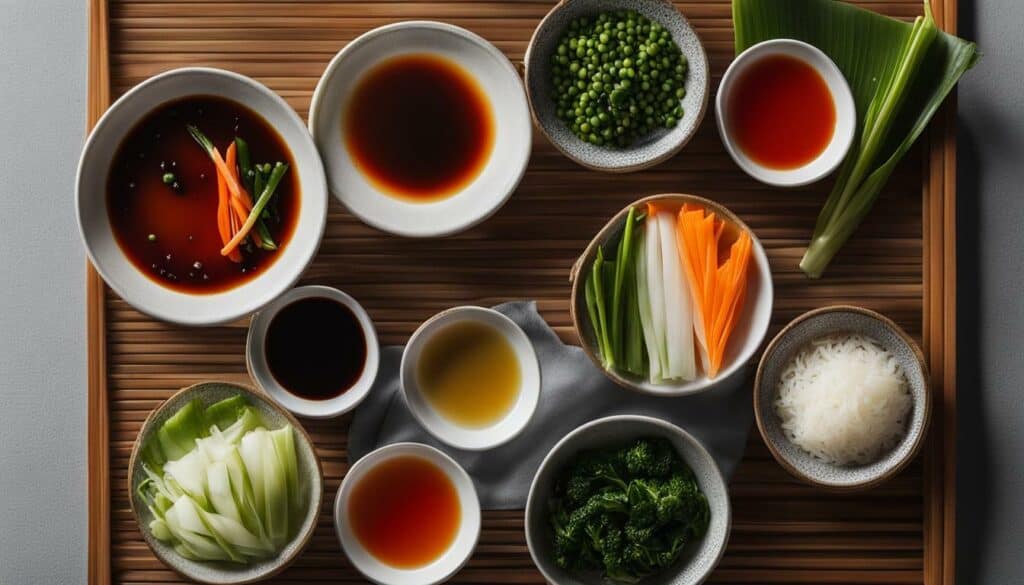
Remember to order a plate of greens to accompany your dim sum feast. Whether it’s sautéed bok choy, steamed broccoli, or stir-fried gai lan, adding greens to your meal can provide additional vitamins, minerals, and fiber. Minimize the use of condiments like soy sauce, as they can be high in sodium. Instead, savor the natural flavors of the dim sum.
To enhance the nutritional value of your dim sum experience, consider complementing your meal with fruits like oranges, kiwis, and apricots. These fruits are rich in antioxidants, vitamins, and fiber. They can provide a refreshing balance to the savory flavors of dim sum.
Steaming is a healthier cooking method for dim sum as it retains the vitamins, minerals, and natural flavors of the ingredients. It also reduces the need for excessive oil, making your dim sum dishes lighter and healthier. By opting for steamed dim sum options, you can enjoy the authentic flavors without compromising your health.
Overall, making mindful choices when it comes to dim sum can help you indulge in this delicious cuisine while still maintaining a balanced diet. By selecting healthier options, adding greens and fruits, and opting for steamed dishes, you can enjoy the benefits of dim sum without worrying about its impact on your health.
Mindful Eating Tips for Healthier Dim Sum
Making mindful choices when enjoying dim sum can help you make it a healthier meal option. While dim sum can be delicious and a popular part of Hongkongers’ lifestyle, it’s important to consider the nutrition facts. Many dim sum dishes are high in calories, fat, and sodium, which can contribute to heart disease.
When ordering dim sum, opt for healthier choices such as shrimp dumplings, scallop dumplings, spinach dumplings, and steamed chicken buns. These options are often lower in calories and saturated fat compared to dishes like offal or sticky rice wrapped in lotus leaf. Additionally, it’s a good idea to order a plate of greens, like steamed Chinese broccoli or bok choy, to add more nutrients and fiber to your meal.
Minimizing the use of condiments like soy sauce can help reduce your sodium intake. Instead, try dipping your dim sum in a light sauce made from vinegar, garlic, or chili to add flavor without the extra sodium. Drinking tea or water with your dim sum meal is also a healthier alternative to sugary beverages.
Don’t forget to complement your dim sum with fruits like oranges, kiwis, and apricots. These fruits can provide additional vitamins, minerals, and antioxidants to your meal. The sweetness of the fruits can also satisfy your craving for something sweet without the added sugar found in some dim sum desserts.
Table: Dim Sum Dish Comparisons
| Dim Sum Dish | Calories | Total Fat (g) | Sodium (mg) |
|---|---|---|---|
| Shrimp Dumplings (Har Gow, 4 pieces) | 180 | 2 | 260 |
| Steamed Chicken Buns (Char Siu Bao, 1 piece) | 160 | 3 | 310 |
| Sticky Rice Wrapped in Lotus Leaf (Lo Mai Gai, 1 piece) | 380 | 13 | 590 |
Remember, moderation is key when enjoying dim sum. It’s okay to indulge in your favorite dishes occasionally, but making healthier choices more often can help you maintain a balanced diet while still savoring the flavors of dim sum. By being mindful of your choices and making informed decisions, you can enjoy dim sum in a healthier way.
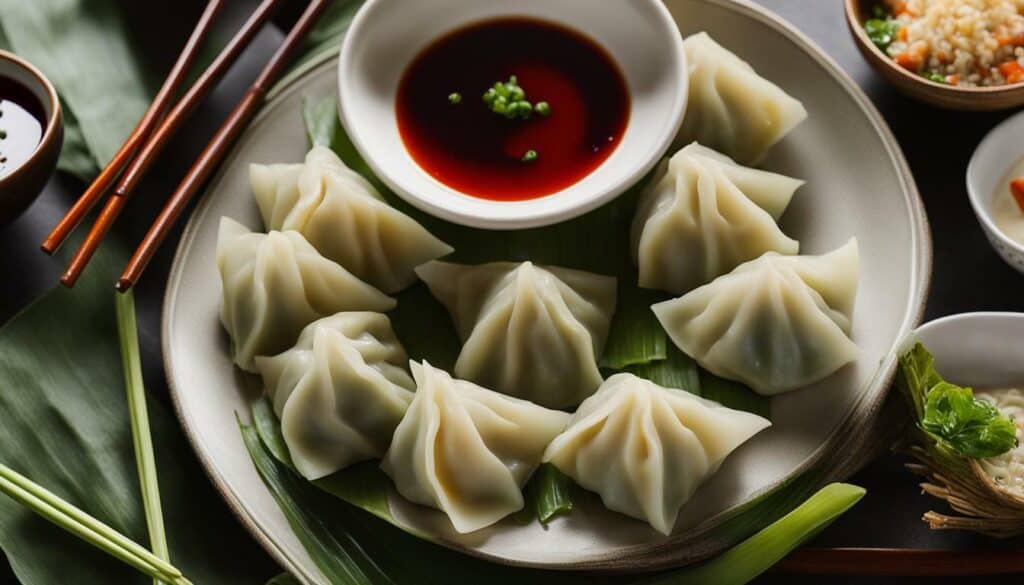
Steaming is a popular cooking method in dim sum preparation, and it has several health benefits. Dim sum dishes that are steamed retain the natural flavors and textures of the ingredients while preserving their nutritional value. Unlike fried or pan-fried dishes that require excessive oil, steaming produces healthier and lighter dim sum options.
When dim sum is steamed, the vitamins, minerals, and antioxidants present in the ingredients are retained, ensuring that you receive the maximum nutritional benefits from your meal. Steamed dim sum dishes are often made with lean proteins such as seafood, chicken, or tofu, which are lower in fat and calories compared to dishes that are deep-fried or stir-fried.
By using steaming as a cooking method, dim sum chefs can create dishes that are flavorful and satisfying, without relying on excessive oil or heavy sauces. Steamed dumplings and buns are a great example of healthier dim sum choices. These delicate parcels are filled with a variety of ingredients such as shrimp, scallops, or spinach, providing a good source of protein, vitamins, and minerals.
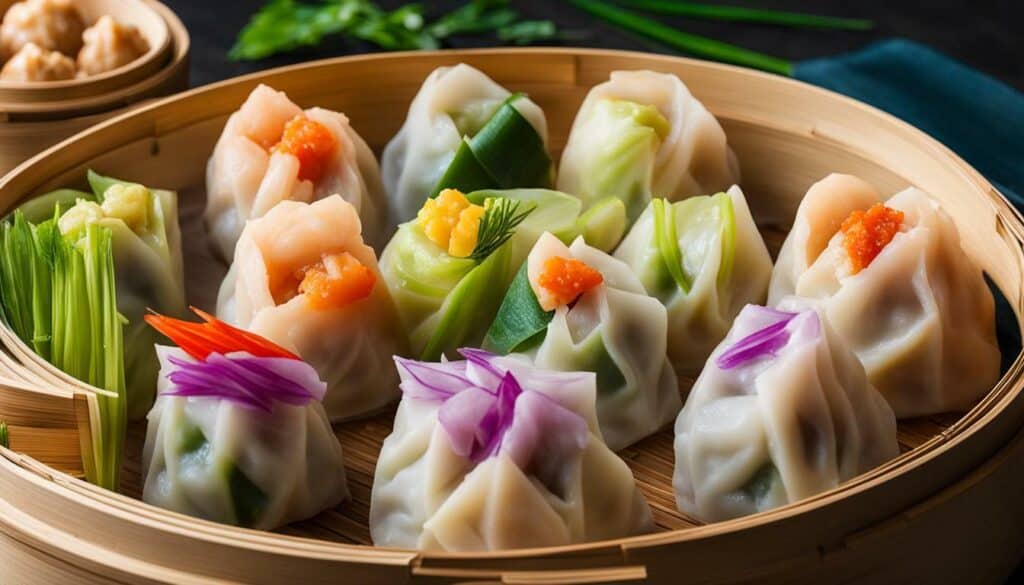
In addition to the health benefits, steaming also contributes to the overall dining experience when enjoying dim sum. The gentle cooking process results in a moist and tender texture, allowing the flavors of the ingredients to shine through. Steamed dim sum is often served in bamboo steamers, adding to the visual appeal and traditional ambiance of the meal.
When selecting dim sum dishes, look for steamed options on the menu. Steamed shrimp dumplings, also known as har gow, and scallop dumplings are excellent choices. These dishes are not only delicious but also provide a good balance of protein and nutrients. Pair your steamed dim sum with a plate of steamed greens such as Chinese broccoli or choy sum to add more fiber and vitamins to your meal.
Conclusion
Enjoying dim sum can be a delightful experience, and by choosing steamed options, you can make it a healthier one too. Steaming helps to retain the nutritional value of the ingredients while creating flavorful and satisfying dishes. So next time you indulge in dim sum, remember to prioritize steamed options for a nourishing and enjoyable dining experience.
Adding Greens and Fruits to Enhance the Nutritional Value
Incorporating greens and fruits into your dim sum meal can add nutritional value and enhance the overall dining experience. Not only do they provide essential vitamins, minerals, and antioxidants, but they also contribute to the vibrant colors and refreshing flavors of the dishes.
When enjoying dim sum, consider ordering a plate of stir-fried or steamed vegetables such as bok choy, Chinese broccoli, or pea shoots. These leafy greens are rich in fiber, vitamins A and C, and calcium. They not only provide a healthy balance to the meal but also add a satisfying crunch and natural sweetness.
Additionally, fruits make a delightful accompaniment to dim sum. Citrus fruits like oranges, mandarins, or grapefruits provide a burst of refreshing flavor and are packed with vitamin C. Kiwis offer a tangy and tropical taste while providing a good source of vitamin K and potassium. Apricots, known for their vibrant color and juicy flesh, are a great source of dietary fiber and antioxidants.
To fully appreciate the nutritional benefits of greens and fruits with your dim sum, it’s important to choose fresh, seasonal produce. By incorporating these wholesome ingredients, you not only enhance the nutritional value of your meal but also create a well-rounded dining experience.
| Fruit | Vitamin C (mg) | Vitamin A (IU) | Potassium (mg) |
|---|---|---|---|
| Oranges | 53.2 | 270 | 326 |
| Kiwis | 64 | 79 | 312 |
| Apricots | 10.6 | 674 | 259 |
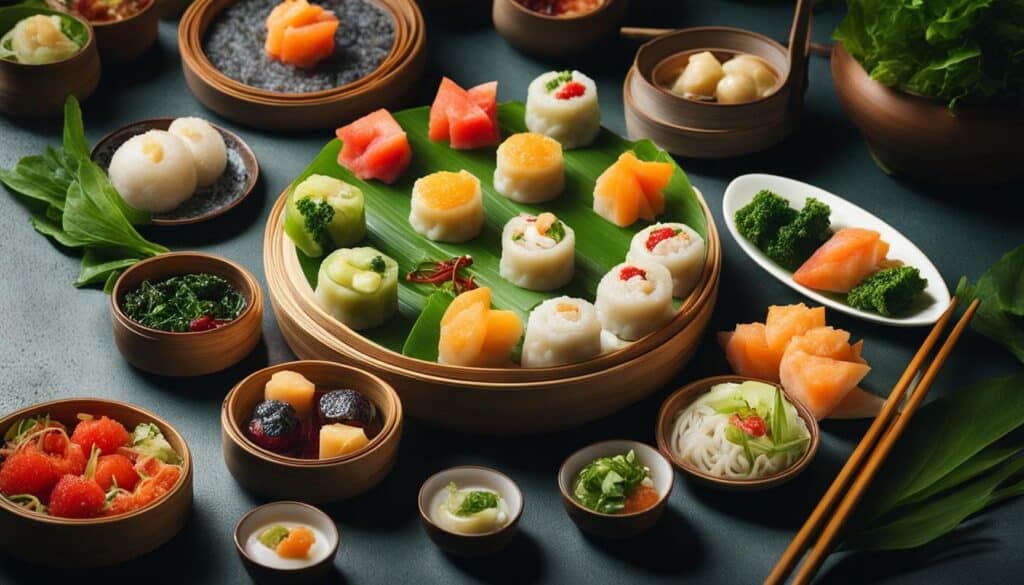
If you enjoy cooking, trying out healthy dim sum recipes at home can be a fun and rewarding experience. Not only will you have control over the ingredients, but you can also adjust the flavors to suit your taste. Here, I’ve gathered a few delicious and nutritious dim sum recipes that you can easily recreate in your own kitchen.
1. Steamed Shrimp Dumplings
Shrimp dumplings, also known as har gow, are a classic dim sum dish that is both tasty and healthy. These dumplings are filled with succulent shrimp and wrapped in a thin, translucent rice flour skin. To make them, simply mix together minced shrimp, water chestnuts, garlic, and ginger. Spoon the mixture onto a round dumpling wrapper and fold it into a pleated shape. Steam the dumplings until cooked through, and serve them with a light soy sauce and chili dipping sauce.
2. Spinach and Mushroom Dumplings
If you’re looking for a vegetarian option, spinach and mushroom dumplings are a fantastic choice. These dumplings are packed with nutrient-rich ingredients and bursting with flavors. To make them, sauté spinach and mushrooms with garlic and soy sauce. Chop the cooked mixture and combine it with tofu, scallions, and sesame oil. Spoon the filling onto dumpling wrappers, seal them, and steam until tender. Serve these dumplings with a tangy ginger soy dipping sauce.
3. Steamed Chicken Buns
Steamed chicken buns, also known as baozi, are soft and fluffy buns filled with savory chicken and aromatic herbs. To make them, marinate chicken thigh meat with oyster sauce, soy sauce, ginger, and garlic. Cook the chicken until tender, shred it, and mix it with chopped scallions and cilantro. Fill the steamed bun dough with the chicken mixture and steam until the buns are puffed up. Serve these delicious buns with a side of chili sauce for an extra kick.
If you’re looking for more healthy dim sum recipes, check out the book “Dim Sum: The Art of Chinese Dumplings” by Ellen Leong Blonder. It’s filled with mouthwatering recipes and tips for making your own dim sum at home.
Remember, while these recipes are healthier alternatives to traditional dim sum dishes, it’s still important to enjoy them in moderation as part of a balanced diet. By incorporating these homemade dim sum recipes into your cooking repertoire, you can savor the flavors of this beloved cuisine while keeping your health goals in mind.
| Recipe | Ingredients | Preparation Time | Serving Size |
|---|---|---|---|
| Steamed Shrimp Dumplings | Shrimp, water chestnuts, garlic, ginger, rice flour wrappers | 30 minutes | Makes 20 dumplings |
| Spinach and Mushroom Dumplings | Spinach, mushrooms, tofu, garlic, soy sauce, sesame oil, dumpling wrappers | 45 minutes | Makes 24 dumplings |
| Steamed Chicken Buns | Chicken thigh meat, oyster sauce, soy sauce, ginger, garlic, scallions, cilantro, steamed bun dough | 1 hour | Makes 12 buns |
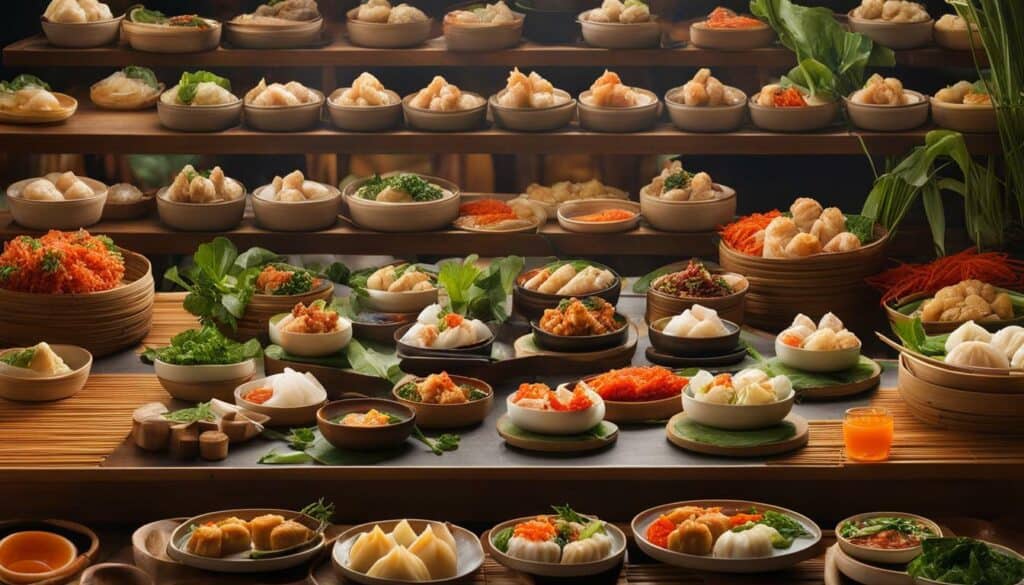
These healthy dim sum recipes offer a taste of the traditional while providing a nutritious twist. Experiment with different fillings and flavors to create your own dim sum masterpieces. Enjoy the satisfaction of making delicious and healthy dim sum at home, and impress your family and friends with your culinary skills. Happy cooking!
Best Dim Sum Dishes for Health Conscious Diners
If you’re health-conscious and want to enjoy dim sum, there are certain dishes that are better choices for you. While many dim sum dishes can be high in calories, fat, and sodium, there are healthier options available that still deliver on flavor. Here are some of the best dim sum dishes to consider:
- Shrimp Dumplings: These delicate dumplings are filled with succulent shrimp and wrapped in a thin, translucent skin. They are low in calories and fat, making them a great choice for health-conscious diners.
- Scallop Dumplings: Made with tender scallops, these dumplings are a delicious and nutritious option. Scallop dumplings are low in calories and high in protein, making them a satisfying choice for dim sum lovers.
- Spinach Dumplings: Packed with nutrients, spinach dumplings are a great way to incorporate greens into your dim sum meal. They are low in calories and fat, while providing a boost of vitamins and minerals.
- Steamed Chicken Buns: These fluffy buns are filled with juicy, flavorful chicken. They are lower in fat compared to other meat-filled dim sum dishes, making them a healthier option.
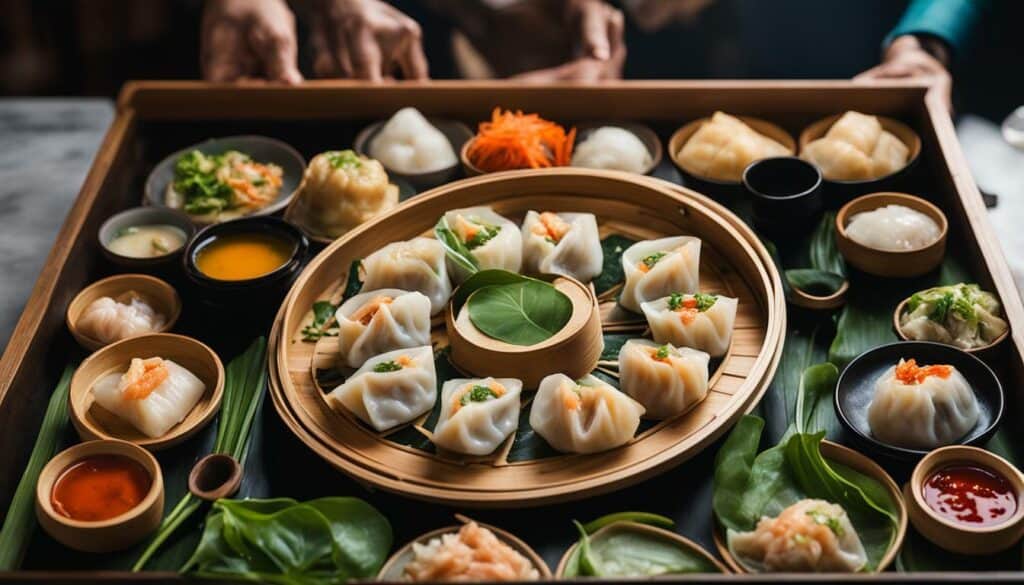
To create a well-rounded and nutritious dim sum experience, it’s also important to complement your meal with additional healthy choices. Order a plate of steamed greens, such as bok choy or gai lan, to add fiber and vitamins to your meal. Minimize the use of condiments like soy sauce, as they can increase the sodium content of your meal. Instead, opt for a light dipping sauce or enjoy the natural flavors of the dim sum. Additionally, choose to drink tea or water with your dim sum, as sugary beverages can add unnecessary calories. Finally, consider adding fruits like oranges, kiwis, and apricots to your dim sum spread. These fruits provide antioxidants and vitamins to enhance the nutritional value of your meal.
The Importance of Steaming in Dim Sum Preparation
One cooking method that stands out for its health benefits in dim sum preparation is steaming. Steaming retains the natural flavors of the ingredients while preserving their nutritional value. It requires little to no oil, reducing the overall fat content of the dish. Steamed dim sum dishes can be a healthier alternative to fried or deep-fried options, as they are lower in calories and saturated fat. By choosing steamed dim sum dishes, you can still enjoy the traditional flavors of dim sum while making a healthier choice for your well-being.
| Dish | Calories per Serving | Fat per Serving | Sodium per Serving |
|---|---|---|---|
| Shrimp Dumplings | 60 | 1g | 180mg |
| Scallop Dumplings | 55 | 0.5g | 160mg |
| Spinach Dumplings | 45 | 0.5g | 200mg |
| Steamed Chicken Buns | 80 | 1.5g | 220mg |
“Steamed dim sum dishes can be a healthier alternative to fried or deep-fried options, as they are lower in calories and saturated fat.”
By choosing the right dim sum dishes and practicing mindful eating, you can enjoy this culinary delight while still prioritizing your health. Remember to make mindful choices, opt for steamed options, include greens and fruits, and savor the flavors of dim sum while keeping your nutritional needs in mind.
Conclusion
In conclusion, dim sum can be a part of a healthy diet, but it’s important to make informed choices and opt for healthier options. While many dim sum dishes are high in calories, fat, and sodium, there are healthier alternatives available. When enjoying dim sum, it’s essential to consider the nutrition facts and select dishes that are lower in calories and fat.
Some of the healthier dim sum options include shrimp dumplings, scallop dumplings, spinach dumplings, and steamed chicken buns. These dishes are lighter and lower in saturated fat compared to other dim sum choices. Additionally, it’s advisable to accompany your dim sum meal with a plate of greens, which can provide essential nutrients and balance out the overall meal.
When ordering dim sum, it’s also important to be mindful of condiments. Minimizing the use of soy sauce or opting for a reduced-sodium version can help reduce your sodium intake. Drinking tea or water instead of sugary beverages can further enhance the healthiness of your meal.
Finally, complementing your dim sum with fruits like oranges, kiwis, and apricots can provide additional vitamins and minerals. These fruits not only add a burst of freshness to your meal but also contribute to a well-rounded and nutritious dining experience.
Steaming is a cooking method commonly used in dim sum preparation, and it offers numerous health benefits. Steaming retains the vitamins, minerals, and natural flavors of ingredients while reducing the need for excessive oil. Therefore, opting for steamed dim sum dishes can help maintain the nutritional value of the cuisine.
By making mindful choices during your dim sum experience and incorporating healthier options, you can enjoy this delicious cuisine while prioritizing your health and well-being. Remember, moderation is key, and it’s essential to strike a balance to fully savor the flavors and nutritional benefits of dim sum.
FAQ
Q: Is dim sum healthy?
A: While dim sum can be a delicious part of Hongkongers’ lifestyle, it’s important to consider the nutrition facts. Many dim sum dishes are high in calories, fat, and sodium, which can contribute to heart disease. However, there are healthier dim sum options available.
Q: What are some high-calorie and fatty dim sum dishes to avoid?
A: Some common culprits include offal, steamed chicken feet with black bean sauce, steamed bean curd sheet roll, meatballs, and sticky rice wrapped in lotus leaf. These dishes can be calorie-dense and fatty.
Q: What are some healthier dim sum choices for a balanced diet?
A: Healthier dim sum options include shrimp dumplings, scallop dumplings, spinach dumplings, and steamed chicken buns. These choices are lower in calories and fat compared to some other dim sum dishes.
Q: How can I eat dim sum mindfully for a healthier meal?
A: It’s important to order a plate of greens, minimize the use of condiments like soy sauce, drink tea or water with the meal, and complement it with fruits like oranges, kiwis, and apricots. These mindful eating tips can help optimize the nutritional value of your dim sum.
Q: Why is steaming an important cooking method for dim sum?
A: Steaming is a healthier cooking method as it retains vitamins, minerals, and reduces the need for oil. Steaming helps preserve the nutritional value of the ingredients used in dim sum dishes.
Q: How can I enhance the nutritional value of my dim sum meal?
A: Adding greens and fruits to your dim sum meal can enhance its nutritional value. Including vegetables like bok choy or gai lan and fruits like oranges or kiwis can provide additional vitamins and minerals to your meal.
Q: Are there any healthy dim sum recipes I can try at home?
A: Yes, there are several healthy dim sum recipes you can try at home. These recipes provide step-by-step instructions and tips for making nutritious and delicious dim sum dishes.
Q: What are some of the best dim sum dishes for health-conscious diners?
A: Some specific dim sum dishes that are particularly healthy and suitable for health-conscious diners include shrimp dumplings, scallop dumplings, and steamed chicken buns. These dishes offer nutritional benefits and are good options for those looking to eat healthier dim sum.
Is Stinky Tofu a Healthy Ingredient in My Favorite Recipe?
Stinky tofu, a popular ingredient in many Asian cuisines, adds a unique flavor to your favorite recipes. While it may not sound tempting, the pungent smell often dissipates during cooking, leaving behind a tasty addition. To incorporate stinky tofu in your recipes, experiment with stir-fries, soups, or even as a topping for noodles. Give your taste buds a flavorful adventure with this unconventional stinky tofu recipe.

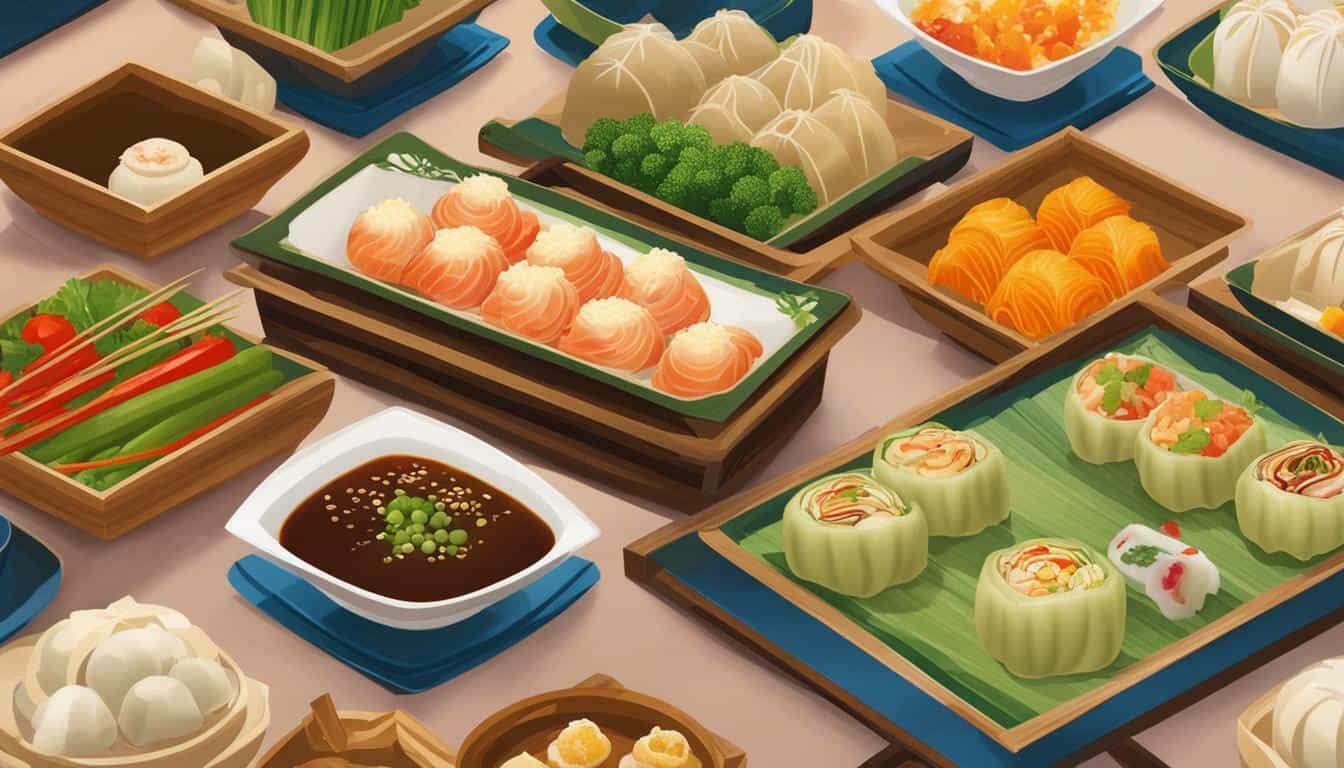



Leave a Reply